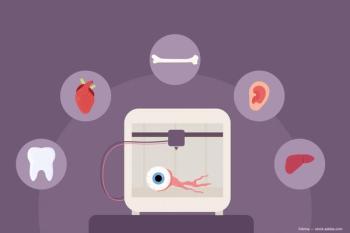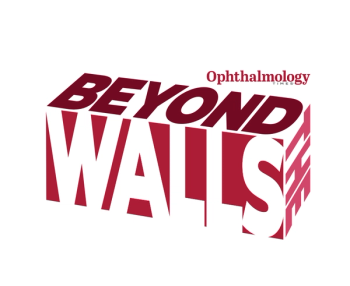
Novel crosslinked HA eye drop shown to enhance corneal epithelium healing
A novel topical high-concentrated, crosslinked hyaluronic acid eye drop could expand the options that surgeons have available for improving wound care, healing, and regenerative medicine for a variety of corneal injuries.
Hyaluronic acid (HA) hydrogels have long been recognized for their dermal and ocular wound-healing properties, ability to support stem-cell regenerative medicines, joint lubrication and cushioning, and ocular hydrating capabilities.1
In Europe and Asia, topical HA is the standard of care for dry eye, as well as other corneal superficial epithelial injuries. Topically applied, non-crosslinked HA eye drops are quickly degraded and cleared.
However, HA can be customized for composition, physical form, and biomechanical properties by crosslinking its chemical structure, resulting in a high-concentrated substance that resists degradation. It also has the ability to stay longer on both dermal and ocular epithelial surfaces than non-crosslinked versions.1,2
NOVEL HA EYE DROP
A novel and proprietary high-concentration, crosslinked HA eye drop was developed that withstands the forces of blinking and tear turnover on the ocular surface.3 Because of its remarkable physical properties as a highly concentrated crosslinked eye drop, this HA drop becomes a transparent and non-blurring fluid that shear thins under the force of the blinking eyelids. By providing a thin coating on the surface of the eye, it serves as a hydrating protectant and lubricant that facilitates acceleration of corneal re-epithelialization.1,4
This high-concentration (0.75%), crosslinked HA has demonstrated to provide a mechanical barrier that aids in the management of corneal epitheliopathies and accelerates re-epithelialization in animals with traumatic corneal injuries and non-healing persistent corneal defects. This has been demonstrated in preclinical studies,2 as well as in "real-world" clinical ophthalmic veterinary use in dogs and cats.3-6
Given the tremendous unmet need in humans for a well-tolerated and easy-to-apply HA agent that can hydrate, lubricate, and accelerate corneal wound repair, EyeGate Pharmaceuticals (Waltham, MA) conducted the first in-human study to evaluate the efficacy of this formulation of HA in subjects with large corneal defects.
"HA is a well-known and trusted substance, but based on the early work in photorefractive keratectomy (PRK) patients, this formulation appears to be very unique," said Dan Durrie, MD, Durrie Vision, Overland Park, KS. "Clinical trials in PRK patients don't necessarily represent the greatest need, but (they) are a very good model to demonstrate wound-healing capabilities, which should have broader applications for our patients.
"I'm excited to see the results of the upcoming trials and where this will lead in treating a variety of epitheliopathies, including dry eye," Dr. Durrie added
SAFETY AND EFFICACY
The objective of the study was to assess the safety and efficacy of this high-concentration, crosslinked HA eyedrop (referred to as the "Ocular Bandage Gel" [OBG] in the trial) in humans with large corneal epithelial defects that were created during refractive surgery.7 OBG was applied topically in accelerating re-epithelialization of 9-mm corneal defects.
The subjects provide a homogenous patient population with a consistent and uniform defect size for comparison between treatment options.
In the randomized, open-label, prospective study, 39 subjects receiving bilateral PRK had both eyes treated immediately after surgery with either the OBG alone administered QID, OBG (QID) and a bandage contact lens (BCL), or a BCL with artificial tears (AT).
Subjects receiving a 9-mm epithelial defect for PRK on day 0 were followed through day 28.
The primary performance endpoint was time to corneal re-epithelialization post-PRK as assessed at the slit lamp. Safety assessments included adverse events, vision, pain, slit lamp, intraocular pressure, and fundus exams.
FASTER RECOVERY
Patients treated with OBG (arm 1) had faster recovery time compared to both comparison and control groups (See Table 1). OBG alone demonstrated accelerated wound healing versus standard of care in roughly 55% more patients as measured as wounds closed on day 3.
Additionally, wound size was as much as ~36% smaller as early as day 1 (24 hours post-surgery) and 83% smaller by day 3 with OBG alone. The safety and tolerability were excellent with no safety concerns nor product related adverse events due to OBG.
The BCL subjects did have 1 patient each in arm 1 and arm 2 with recurrent epithelial defects occurring after the BCL was removed, requiring the BCL to be replaced.7
Clinical therapies are needed that can be easily applied topically to accelerate the repair of a variety of corneal and surface epithelial injuries. Based on the pilot study, this high-concentration, crosslinked HA eye drop demonstrated the ability to effectively and safely accelerate re-epithelialization of large corneal epithelial defects created during PRK.
DROP EXPANDS OPTIONS
This drop could expand the number of options that surgeons have available for improving ocular wound care, healing, and regenerative medicine for a variety of corneal injuries.
"The long track record of animal safety and efficacy combined with EyeGate's human clinical data are very exciting," said Randall Olson, MD, chairman, Ophthalmology Department; CEO, Moran Eye Center, University of Utah, Salt Lake City. "Something that safely and easily enhances corneal epithelium healing has long been needed and may soon be in our grasp. We all await the results of the next study with great hope."
This polymer also could be an excellent adjunctive therapy to current treatments, given it is unique and complimentary hydrating and protectant mechanism of action in a convenient and easy-to-apply drop form. This product offers an exciting, well-tolerated, and effective topical therapy for repairing and quickly re-epithelializing the cornea following various causes of epithelial damage, including trauma, disease, punctate epitheliopathies, dry eye, and or surgery.
EyeGate is conducting clinical studies in patients with both large epithelial defects created during PRK, as well as subjects with small micro-abrasions and or punctate epitheliopathies. Based on the clinical results, a 510 K de Novo submission to the FDA is planned for late 2018 to early 2019.
Disclosures:
BARBARA WIROSTKO, MD
E: [email protected]
Dr. Wirostko is chief medical officer for EyeGate Pharmaceuticals; co-founder of Jade Therapeutics; and adjunct professor of ophthalmology, Moran Eye Center, University of Utah, Salt Lake City. She is also a stockholder in EyeGate.
References:
1. Wirostko B, Mann BK, Williams DL, Prestwich GD. Ophthalmic uses of a thiol-modified hyaluronan-based hydrogel. Adv Wound Care (New Rochelle) 2014; 3:708-716.
2. Yang G, Prestwich GD, Mann BK. Thiolated carboxymethyl-hyaluronic-Acid-based biomaterials enhance wound healing in rats, dogs, and horses. ISRN Vet Sci 2011; Article ID 851593. doi: 10.5402/2011/851593. Accessed July 7, 2017 at http://dx.doi.org/10.5402/2011/851593
3. Williams DL, Mann BK. A crosslinked HA-based hydrogel ameliorates dry eye symptoms in dogs. Int J Biomater 2013, Article ID 460437. Accessed July 7, 2017 at http://dx.doi.org/10.1155/2013/460437
4. Yang G, Espandar L, Mamalis N, Prestwich GD. A crosslinked hyaluronan gel accelerates healing of corneal epithelial abrasion and alkali burn injuries in rabbits. Vet Ophthalmol 2010; 13:144-150.
5. Williams DL, Wirostko BM, Gum G, Mann B. Topical crosslinked HA-based hydrogel accelerates closure of corneal epithelial defects and repair of stromal ulceration in companion animals. Invest Ophthalmol Vis Sci. 2017;58:4616-4622. doi: 10.1167/iovs.16-20848.
6. Williams DL, Mann BK. Efficacy of a crosslinked hyaluronic acid-based hydrogel as a tear film supplement: a masked controlled study. PLoS ONE 2014; 9: e99766. doi:10.1371/journal.pone.0099766. Accessed July 7, 2017 at http://journals.plos.org/plosone/article?id=10.1371/journal.pone.0099766
7. Daniel S. Durrie MD, Darcy Wolsey, MD, MPH, Vance Thompson, MD, Carol Assang, Brenda Mann, PhD, Barbara Wirostko, MD. Accelerating re-epithelialization after photorefractive keratectomy with an ocular bandage gel. Journal of Cataract and Refractive Surgery. Accepted and in press Nov 2017.
Newsletter
Don’t miss out—get Ophthalmology Times updates on the latest clinical advancements and expert interviews, straight to your inbox.
















































.png)


